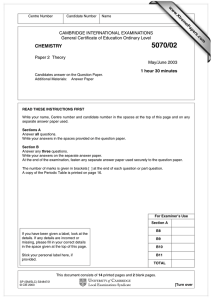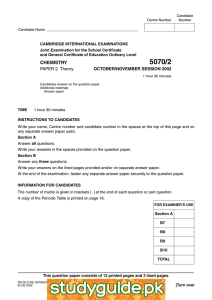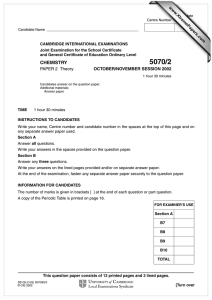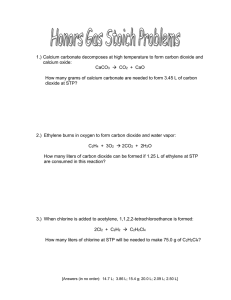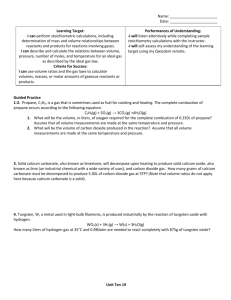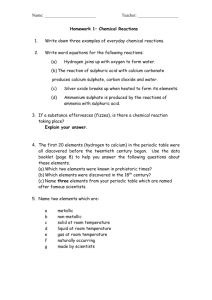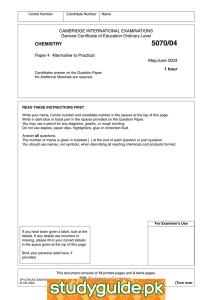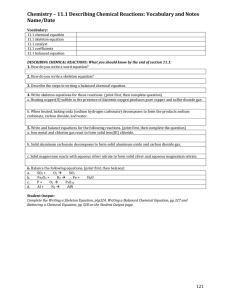5070/02 CHEMISTRY
advertisement
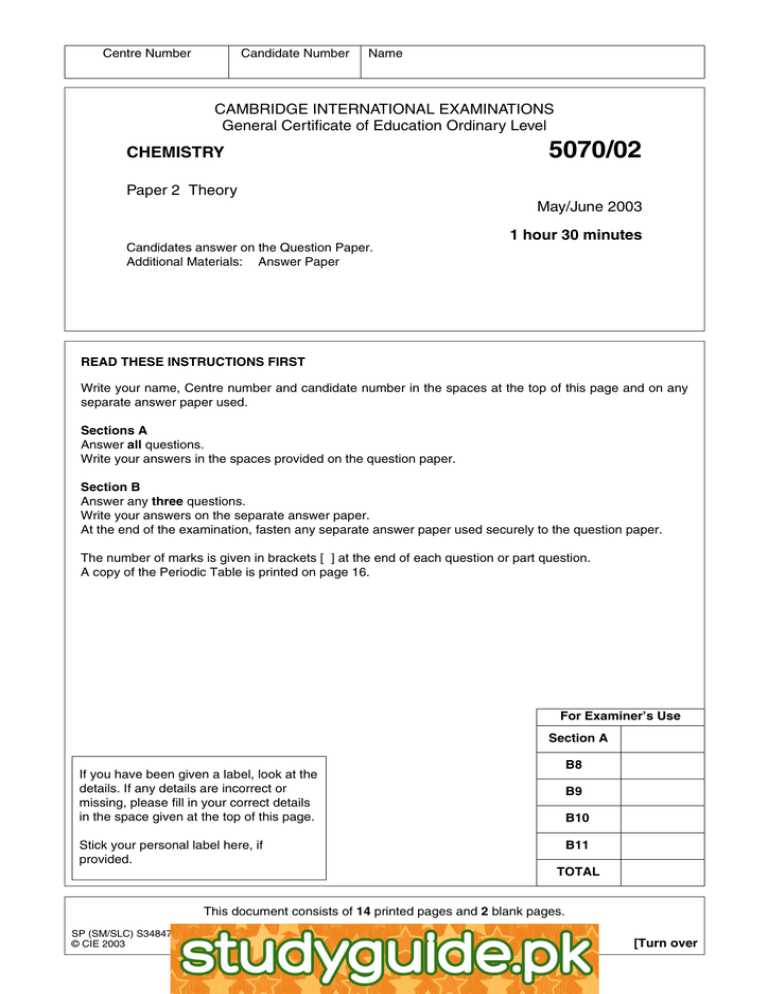
Centre Number Candidate Number Name CAMBRIDGE INTERNATIONAL EXAMINATIONS General Certificate of Education Ordinary Level 5070/02 CHEMISTRY Paper 2 Theory May/June 2003 1 hour 30 minutes Candidates answer on the Question Paper. Additional Materials: Answer Paper READ THESE INSTRUCTIONS FIRST Write your name, Centre number and candidate number in the spaces at the top of this page and on any separate answer paper used. Sections A Answer all questions. Write your answers in the spaces provided on the question paper. Section B Answer any three questions. Write your answers on the separate answer paper. At the end of the examination, fasten any separate answer paper used securely to the question paper. The number of marks is given in brackets [ ] at the end of each question or part question. A copy of the Periodic Table is printed on page 16. For Examiner’s Use Section A B8 If you have been given a label, look at the details. If any details are incorrect or missing, please fill in your correct details in the space given at the top of this page. B9 B10 B11 Stick your personal label here, if provided. TOTAL This document consists of 14 printed pages and 2 blank pages. SP (SM/SLC) S34847/2 © CIE 2003 [Turn over www.xtremepapers.net For Examiner’s Use 2 Section A Answer all the questions in this section in the spaces provided. A1 Choose from the following elements to answer the questions below. argon bromine carbon hydrogen iodine iron neon sulphur Each element can be use used once, more than once, or not at all. Name an element which (a) forms a basic oxide, ......................................................................................................................................[1] (b) is a liquid at room temperature and pressure, ......................................................................................................................................[1] (c) reacts with aqueous copper(II) sulphate to give a pink solid, ......................................................................................................................................[1] (d) is formed during the electrolysis of concentrated aqueous sodium chloride, ......................................................................................................................................[1] (e) has a giant molecular structure. ......................................................................................................................................[1] 5070/02/M/J/03 www.xtremepapers.net 3 A2 Ethanol, CH3CH2OH, is a liquid fuel. Ethanol can be manufactured either from glucose, C6H12O6, or from ethene. For Examiner’s Use (a) Briefly describe the manufacture of ethanol from glucose. Include the balanced equation in your answer. .......................................................................................................................................... .......................................................................................................................................... .......................................................................................................................................... ......................................................................................................................................[4] (b) (i) (ii) Draw the displayed formula for ethene. Name the substance that reacts with ethene to make ethanol. ................................................................................................................................... (iii) Give the conditions needed for this reaction. ................................................................................................................................... ................................................................................................................................... [4] 5070/02/M/J/03 www.xtremepapers.net [Turn over 4 A3 Petroleum is a complex mixture of hydrocarbons. Petroleum is a source of many useful fuels. (a) What is meant by the term hydrocarbon? .......................................................................................................................................... ......................................................................................................................................[1] (b) Petroleum is separated by fractional distillation. (i) Complete the following table about the fractions obtained from petroleum. use fraction petrol (gasoline) fuel for cars paraffin (kerosene) diesel fuel for diesel engines bitumen (ii) Name one other fraction obtained from petroleum. ................................................................................................................................... [3] (c) Fractional distillation of petroleum does not produce sufficient of some fractions to match demand. Cracking is used to convert large hydrocarbon molecules into smaller molecules that are more in demand. A hydrocarbon of molecular formula C12H26 is cracked. (i) Suggest the formula of one alkane that may be produced. ................................................................................................................................... (ii) Suggest the formula of one alkene that may be produced. ................................................................................................................................... (iii) Describe a chemical test that can be used to distinguish between an alkene and an alkane. chemical test ............................................................................................................. result with alkane ...................................................................................................... result with alkene ...................................................................................................... [4] 5070/02/M/J/03 www.xtremepapers.net For Examiner’s Use 5 A4 Carbon dioxide is a greenhouse gas. Carbon dioxide is given a greenhouse factor of 1. Other gases are given a greenhouse factor that compares their effect with carbon dioxide. The greenhouse effect increases as the factor value increases. The table gives some information about four different gases. gas greenhouse factor percentage of gas in the atmosphere CO2 1 0.036 CH4 30 0.0017 N2O 160 3.0 ⫻ 10–4 CCl3F 21000 2.8 ⫻ 10–8 For Examiner’s Use (a) State one possible consequence of an increased greenhouse effect. ......................................................................................................................................[1] (b) Give one source of methane. ......................................................................................................................................[1] (c) Why is an increase in the percentage of methane more worrying than the same percentage increase of carbon dioxide? .......................................................................................................................................... ......................................................................................................................................[1] (d) What other environmental problem, beside its action as a greenhouse gas, is caused by CCl3F? ......................................................................................................................................[1] 5070/02/M/J/03 www.xtremepapers.net [Turn over 6 A5 Marble statues are being damaged by acid rain. The chemical name for marble is calcium carbonate. A student investigated the reaction between marble chips and nitric acid. CaCO3(s) + 2HNO3(aq) → Ca(NO3)2(aq) + H2O(l) + CO2(g) The diagram shows the apparatus the student used. 50 cm3 of 2.0 mol/dm3 nitric acid 2.0 g marble chips 93.30 g The student recorded the balance reading every minute. The table shows the results. time / minutes balance reading / g 0 1 2 3 4 5 6 7 8 9 10 11 12 13 14 93.30 93.28 93.26 93.24 93.22 93.21 93.20 93.19 93.18 93.17 93.16 93.15 93.15 93.14 93.14 (a) Explain why the balance reading decreases during the experiment. .......................................................................................................................................... ......................................................................................................................................[1] (b) How can the student tell when the reaction has finished? .......................................................................................................................................... ......................................................................................................................................[1] 5070/02/M/J/03 www.xtremepapers.net For Examiner’s Use For Examiner’s Use 7 (c) (i) Calculate the number of moles of nitric acid in 50 cm3 of 2.0 mol / dm3 solution. (ii) Calculate the number of moles of calcium carbonate in 2.0 g. (iii) Which reagent, calcium carbonate or nitric acid, is in excess? Explain your answer. [5] (d) The student repeats the experiment using the same quantities of calcium carbonate and nitric acid. This time the acid is at a higher temperature. Describe and explain, in terms of collisions between reacting particles, the effect of increasing the temperature on the rate of reaction. .......................................................................................................................................... .......................................................................................................................................... ......................................................................................................................................[2] 5070/02/M/J/03 www.xtremepapers.net [Turn over 8 A6 A student adds aqueous sodium hydroxide from a burette into 25.0 cm3 of dilute sulphuric acid. The student measures the pH value of the mixture during the addition of the sodium hydroxide. (a) Describe how the pH value changes. ......................................................................................................................................[1] (b) Give an ionic equation to represent the neutralisation reaction between sodium hydroxide and sulphuric acid. ......................................................................................................................................[1] (c) Sulphuric acid is a strong acid. (i) What is meant by the term acid ? ................................................................................................................................... ................................................................................................................................... (ii) What is the difference between a strong acid and a weak acid? ................................................................................................................................... ................................................................................................................................... ................................................................................................................................... [3] (d) Dilute sulphuric acid reacts with magnesium to give hydrogen. Give the ionic equation for this reaction. ......................................................................................................................................[1] 5070/02/M/J/03 www.xtremepapers.net For Examiner’s Use For Examiner’s Use 9 A7 The structures of two ionic lattices are shown below. O2– Mg2+ Mg2+ Cl – O2– Mg2+ O2– Na+ Na+ Cl – O2– Na+ Mg2+ Cl – magnesium oxide Cl – Na+ sodium chloride (a) Explain why these two solids do not conduct electricity. .......................................................................................................................................... ......................................................................................................................................[1] (b) (i) Explain why magnesium oxide has a very high melting point. ................................................................................................................................... ................................................................................................................................... (ii) Suggest why the melting point of magnesium oxide is much higher than that of sodium chloride. ................................................................................................................................... ................................................................................................................................... ................................................................................................................................... [2] (c) Draw the electronic structure of a magnesium ion and of an oxide ion. magnesium ion oxide ion [2] 5070/02/M/J/03 www.xtremepapers.net [Turn over 10 Section B Answer three questions from this section. B8 The NASA space shuttle uses fuel cells to generate electricity. The diagram below shows a hydrogen-oxygen fuel cell. external circuit hydrogen in oxygen in Na+ (aq) electrolyte negative electrode positive electrode OH– (aq) water At the positive electrode, oxygen reacts with water as shown. O2(g) + 2H2O(l) + 4e– → 4OH–(aq) At the negative electrode, hydrogen reacts with hydroxide ions as shown. H2(g) + 2OH–(aq) → 2H2O(l) + 2e– The overall reaction in the fuel cell is the reaction between hydrogen and oxygen to make water. (a) Give one source for hydrogen and one source for oxygen for use in a fuel cell. [2] (b) What is the name of the electrolyte used in the fuel cell? [1] (c) What type of reaction takes place, reduction or oxidation, at the positive electrode? Explain your answer. [1] (d) A fuel cell uses 240 dm3 of hydrogen. Calculate the volume of oxygen needed, and the mass of water formed. All gas volumes measured at room temperature and pressure. [3] (e) Describe some advantages and disadvantages of using a fuel cell to generate electricity. [3] 5070/02/M/J/03 www.xtremepapers.net 11 B9 The table gives information about the first five members of the homologous series of carboxylic acids. name of acid formula relative molecular mass melting point / °C boiling point / °C methanoic acid HCO2H 46 8.4 101 ethanoic acid CH3CO2H 60 17 118 propanoic acid C2H5CO2H 74 –22 141 butanoic acid C3H7CO2H 88 –8 164 pentanoic acid (a) (i) (ii) Predict the formula and the relative molecular mass for pentanoic acid. Explain why it is easier to predict the boiling point of pentanoic acid than the melting point. [3] (b) Draw the displayed formula for propanoic acid. [1] (c) Analysis of an organic acid isolated from red ants shows that it contains 0.060 g of carbon, 0.010 g of hydrogen and 0.16 g of oxygen. Calculate the empirical formula for this acid. [2] (d) Ethanoic acid reacts with magnesium oxide. Name the products formed and write a balanced equation for the reaction. [2] (e) Describe how ethanoic acid can be converted into ethyl ethanoate. [2] 5070/02/M/J/03 www.xtremepapers.net [Turn over 12 B10 Methane, CH4, is used as a fuel. The complete combustion of methane can be represented by the equation below. H H C H + 2O O O C O + 2 O H H H ∆H = –890 kJ/mol (a) Explain why this reaction is exothermic in terms of the energy changes that take place during bond breaking and bond making. [3] (b) Calculate the energy released when 4.0 g of methane is completely combusted. [2] (c) Draw the energy profile diagram for the complete combustion of methane. Label on the diagram the activation energy and the enthalpy change. [3] (d) Draw a ‘dot and cross’ diagram to show the bonding in methane. You only need to draw the outer (valence) electrons of carbon. [2] 5070/02/M/J/03 www.xtremepapers.net 13 B11 Coal-burning power stations produce sulphur dioxide and oxides of nitrogen. These two gases cause acid rain. (a) Nitric oxide, NO, is made in a power station when nitrogen and oxygen react together. Write the equation for this reaction. [1] (b) Many coal burning power stations are now fitted with a flue gas desulphurisation plant which removes sulphur dioxide and nitrogen dioxide from the gaseous emissions. In a flue gas desulphurisation plant, powdered calcium carbonate reacts with sulphur dioxide as shown. SO2(g) + CaCO3(s) → CaSO3(s) + CO2(g) (i) Suggest why the calcium carbonate is powdered. [1] (ii) Calculate the mass of calcium carbonate needed to react with 8000 kg of sulphur dioxide. [3] (iii) Nitrogen dioxide also reacts with calcium carbonate. Suggest the name of the solid product of this reaction. [1] (c) In the air sulphur dioxide reacts with nitrogen dioxide forming sulphur trioxide. The reactions that take place are shown in the equations. SO2 + NO2 2NO + O2 → → SO3 + NO 2NO2 Suggest the role of nitrogen dioxide in these reactions. Explain your answer. (d) Sulphur dioxide is used in the Contact process to make sulphuric acid. Describe the conditions and name the catalyst in the Contact process. 5070/02/M/J/03 www.xtremepapers.net [2] [2] 14 BLANK PAGE 5070/02/M/J/03 www.xtremepapers.net 15 BLANK PAGE 5070/02/M/J/03 www.xtremepapers.net Magnesium Sodium Calcium Strontium 5070/02/M/J/03 www.xtremepapers.net 89 Key b X a † 72 b = proton (atomic) number X = atomic symbol a = relative atomic mass *58-71 Lanthanoid series †90-103 Actinoid series 88 Ac Actinium Ra Radium Fr Francium 87 * Hafnium Lanthanum 57 178 Hf 40 Zirconium Zr 91 Titanium 139 Yttrium 22 48 Ti La 39 Y 89 Scandium 21 227 56 Barium Caesium 45 Sc 226 55 137 Ba 133 Cs 38 Rubidium 37 88 Sr 85 Rb 20 Potassium 19 40 Ca 39 12 24 Mg 23 Na Beryllium 4 Lithium K 11 3 9 Be 7 II Li I 51 93 Ta 181 Niobium Nb 90 58 73 52 96 Mo W 184 Protactinium Thorium 55 Tc 186 Re 144 Nd 92 60 Uranium U 238 Neodymium 75 Rhenium 43 Technetium 25 Manganese Mn 27 59 28 59 29 64 30 65 5 Ru 101 Iron 190 Pm Osmium Os Np 93 Neptunium 61 Promethium 76 44 Ruthenium 26 56 Fe Sm 150 Iridium Pu 94 Plutonium 62 152 Eu Am 95 Americium 63 Europium 78 Platinum 195 Pt Ir 46 Palladium Pd 106 Nickel Ni 192 Samarium 77 45 Rhodium Rh 103 Cobalt Co Gd 157 Gold Au 197 Silver 96 64 Curium Cm Gadolinium 79 47 Ag 108 Copper Cu 201 Bk Terbium Tb 159 Mercury Hg 97 Berkelium 65 80 48 Cadmium Cd 112 Zinc Zn 11 6 Dy 162 Thallium Tl 204 Indium Cf 98 Californium 66 Es Holmium Ho 165 Lead Pb 207 Tin 99 Einsteinium 67 82 50 119 Sn 115 32 Germanium Ge 73 Silicon In Gallium Dysprosium 81 49 31 70 Ga 14 28 Si Carbon 27 Aluminium 13 12 C Al Boron B 7 14 75 Sb 122 Arsenic As Bi 209 Fermium Fm Erbium Er 167 Bismuth 100 68 83 51 Antimony 33 15 Phosphorus P 31 Nitrogen N 8 Se 79 Sulphur S 32 Oxygen Po 169 Md Thulium Tm 101 Mendelevium 69 84 Polonium 52 Tellurium Te 128 Selenium 34 16 16 O 9 Yb 173 Astatine At Iodine I 127 Bromine Br 80 Chlorine No 102 Nobelium 70 Ytterbium 85 53 35 17 Cl 35.5 Fluorine F 19 Lr Lutetium Lu 175 Radon Rn Xenon Xe 131 Krypton Kr 84 Argon Ar 40 Neon 103 Lawrencium 71 86 54 36 18 10 Ne 20 Helium 2 0 Hydrogen VII 4 VI He V 1 IV H III The volume of one mole of any gas is 24 dm3 at room temperature and pressure (r.t.p.). 91 Pa Th 232 Praseodymium Cerium 59 141 Pr 140 74 Tungsten 42 Molybdenum 24 Chromium Cr Ce Tantalum 41 23 Vanadium V 1 Group DATA SHEET The Periodic Table of the Elements 16
